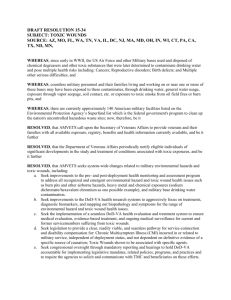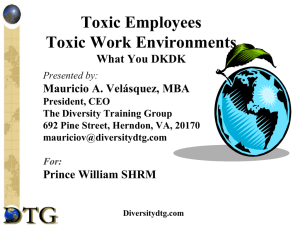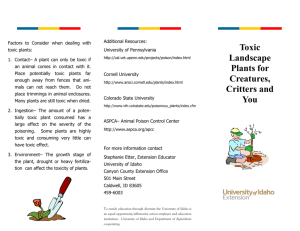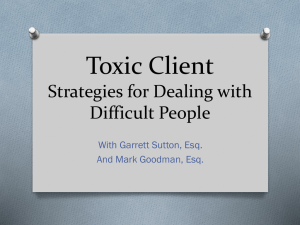Toxic Employees Toxic Work Environments
advertisement
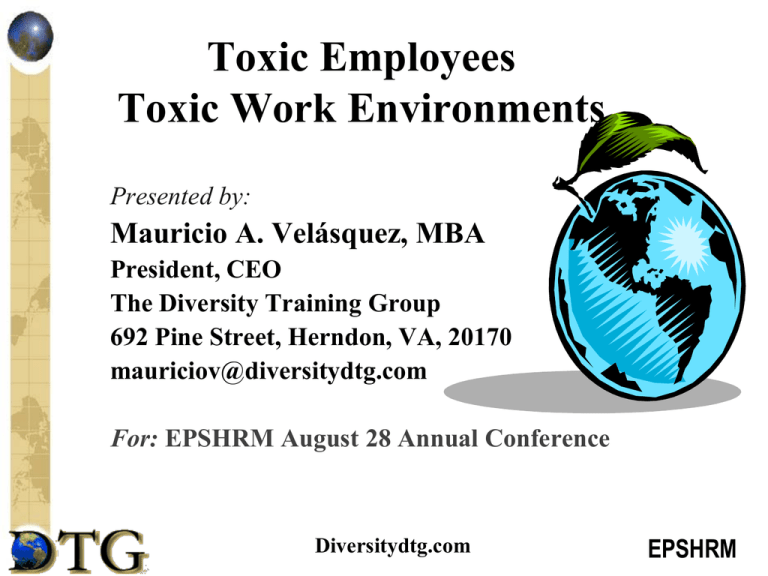
Toxic Employees Toxic Work Environments Presented by: Mauricio A. Velásquez, MBA President, CEO The Diversity Training Group 692 Pine Street, Herndon, VA, 20170 mauriciov@diversitydtg.com For: EPSHRM August 28 Annual Conference Diversitydtg.com EPSHRM About Mauricio Mauricio Velásquez is the President and CEO of The Diversity Training Group (DTG) in Herndon, VA. Mauricio serves as a diversity strategy consultant, diversity trainer, sexual harassment prevention trainer, executive coach, mentoring trainer, and expert witness. Mauricio holds a BA (Economics, Psychology double major) from UVA and an MBA from GWU. DTG’s client include small and large, public and private and not-forprofit organizations. US Postal Service, Habitat for Humanity, MBP, Metro Washington Airports Authority, schools, law enforcement, military – are all clients. Mauricio has trained more than a half million participants in every state but North Dakota. With recent work in Cuba, Italy, Spain, Guam (United States Navy) work and life has taken Mauricio to over 75 countries. Mauricio is married and has three kids – Ethan (15), Elise (13), and Maya (10) and he is active in dealing with the toxicity in his own family. Diversitydtg.com EPSHRM About Toxic Employees, Environments What You Don’t Know You Don’t Know (DKDK) What You Don’t Know (DK) What You Know (K) EPSHRM We all mean well but… Intent (What you meant to say) MEAN TO SAY/DO vs. Impact (What you actually said) ACTIONS/RESULTS EPSHRM Why is this topic so popular? EPSHRM In The News - Everyday Shootings everywhere – Toxicity gone wild Congress, politics Bad economy (insecurity, ambiguity) Economic times make employers and employees do crazy things They have always been this way – no surprise, no change – “accept me” People “don’t say anything” Toxic person is the “last to know” – who me? “People allowed to be awful” – most important – organization knew EPSHRM My Favorite Toxic Participants “I will take anybody but that guy Mauricio” “I don’t give a flying (blank) what this is about, I am not interested!” My “Alaskan Moment of Truth” “You can’t train all of us, some of us you will have to kill!” EPSHRM Agenda Today Understand the toxic employee Understand the toxic work environment Learn how to deal with toxic employees and toxic work environments Relationship between Toxicity, Engagement and High Performance Toxicity and “Being a World Class Organization” Build a tool kit/skill kit and plan of action EPSHRM Mauricio’s Mission • • • • • • Provoke Thought Facilitate Discussion and Learning Surprise You/Entertain You - Edutain Add Value Provide Subject Matter Expertise Make it interactive and “harness talent in this room” • #1 Ground Rule: PARTICIPATE - Ask Questions!!! EPSHRM Toxic Employee (family member) • When you hear the phrase - “toxic employee” what pops into your head? EPSHRM Toxic Employee / Family Member • Always unhappy and negative but they don’t keep their misery to themselves. • Why? Because misery loves company! • Body language tells it all • Glass is always half empty • Incredible memory – remembers stuff from years ago • Love to say “Not my job!” • Recruit people to “join them, share their views” • Always “looking for proof” EPSHRM Toxic Employee (Continued) • Can also be bigoted – negativity is projected towards a particular group – gender, race, age, sexual orientation, religion, management or new management • Can be a bully – big, loud, angry (back of my mind – potential for violence in the workplace) • Always recruiting!.... Always approach new hires – “Let me tell you who to watch out for! You with me?” – “Get that smile off your face – don’t you know where you work? Slow it down. You are making the rest of us look bad!” (Encourage mediocrity!) • Ultimate risk - sabotage EPSHRM Toxic Work Environment • When you hear the phrase - “toxic work environment” what pops into your head? • Toxic family environment? EPSHRM TE “Poisons” the work environment • First – we all know who they are! • But what do we do about them? – Send them to individual 1:1 coaching or – Train everyone – “dip everybody” and sometimes the TE does not even show up – Or do nothing until something happens – what I call a “moment of truth” – Too many organizations contact us with a reactionary posture or “a real sense of urgency” – Don’t wait – sometimes it is too late – Ignoring these issues/this person – does not mean they go away! EPSHRM The Perfect Toxic Storm • Toxic employee or manager is a bully (well known) • They have a false sense of security – they have never been challenged • How does TE interpret silence of peers? • Peers are avoiders of conflict or they expect “Manager to do something!” BUT – Manager is not skilled to deal with TE – Could be a “Reluctant Manager” – Manager is the smartest and promoted for their technical expertise but they don’t have the interpersonal/human relations skills = DKDK and they MEAN WELL EPSHRM What does all of this toxicity have in common? What DTG keeps coming across.. Massive Conflict Avoidance! No cost-benefit analysis – cost of doing nothing was not calculated If we deny the issues exist If we look the other way – these issues go away by themselves or If we look the other way – these issues will just “work themselves out” Total break down in trust They don’t go away, they fester, they escalate! EPSHRM Trust & Conflict – Go Hand in Hand Stephen M. R. Covey – in his book: The Speed of Trust talks about Trust - Taxes and Dividends When there is high trust – there is an actual dividend for this trust – tasks, work, progress, cooperation, collaboration success is easier When there is low or nonexistent trust – there is an actual tax – tasks, work, is harder, indifference, bogged down, sabotage I highly recommend you read this book for your employer, for your kids, for your families and jobs, of course! EPSHRM Trust Behaviorally (no names) What builds trust What undermines it What does it look like Not look like SPAC 2015 Trust Defined “Trust means confidence. The opposite of trust is suspicion. When you trust people, you have confidence in them – in their integrity, and in their abilities. When you distrust people, you are suspicious of them – of their integrity, their agenda, their capabilities or their track record.” S.M.R. Covey Toxic Individuals are often suspicious and spread suspicion throughout their ranks and create and nurture and welcome long time unresolved conflict because it “maintains the toxicity.” SPAC 2015 Toxicity and Being in a Healthy Toxic Environments Healthy Environments Demotivating Disengagement is norm Active disengagement is encouraged Allow unresolved conflict to fester Low performing Lo to nonexistent trust Motivating Engagement is norm Active engagement is role modeled Identify and address conflict High performing Hi trust SPAC 2015 S.M.R. Covey says…. “Leadership is getting results in a way that inspires trust.” Trust is the key…. You don’t trust toxic individuals, toxic work environments are not trustworthy. SPAC 2015 So how do we create a more… Effective Respectful Trusting Highly Engaged …work environment and workplace culture (family culture)? Or, a less Toxic Workplace? SPAC 2015 You have to say something.. You have to do something Saying or doing nothing is not an option / No innocent bystanders If you are not part of the solution – you are part of the problem SPAC 2015 Now for Specific Tools I want to give you, build you a tool kit, a skill kit These tools work if you use them! It is up to you – to use them!! EPSHRM Approach is Key PERSON SEPARATE BEHAVIOR EPSHRM Critical – Your 1st Reaction (Public) “Ouch” “Really” “Really?” “Really!” “Come on now….” If you have core values – time to remind person of these values (real or aspirational) Again, if you don’t say something – how is your silence interpreted? EPSHRM Start-Stop Coaching Tip Start with a Positive Please stop_______________________________________ (describe negative/unproductive behavior) Start_____________________________________________ (describe new, more appropriate/positive behavior) Continue_________________________________________ (describe ongoing positive behavior) End with a Positive SPAC 2015 I- Message Coaching Statement (Start with a Positive) When you ___________________, I feel ______________________ (describe behavior) (impact of behavior) I would prefer ___________________________________________ (new behavior – more appropriate/productive) OR I feel _____________________, when you ____________________ (impact of behavior) (describe behavior) I would prefer ___________________________________________ (new behavior – more appropriate/productive) OR When I see ______________, it makes me feel ____________________ (describe behavior) (impact of behavior on you/group) I would prefer _______________________________________________ (new behavior – more appropriate, more productive) (End with a Positive) SPAC 2015 2 Kinds of Behaviors PREFERS - Promote respect - Diversity friendly - Inclusive - Promotes trust - POSITIVE, HEALTHY NEVERS - Disrespect - Bias/prejudice - Exclusive - Undermine trust - TOXIC Read “The Advantage” Lencioni SPAC 2015 Impact of a SFP – how toxicity spreads pes eoty r e t S Pr eju dice te rp re ta t io n DIVERSITY eptio n Bias Co n In fir m in g Perc Im p In act “H di o vi n ow af du th fe my al e ct o ac th t er ion s” s s/ r o vi ns ple” a h io eo Be Act at p ow “H I tre SPAC 2015 Every toxic situation – problem, rc, solution Step ? Action Example Identify and agree on the problem (consensus) Ask the right questions. Ask for the facts Verify the information Decide what else you need to know “Help me understand exactly” “Let me make sure this is recorded correctly” “I will be able to help you better if I know…” Conduct problemcause analysis to identify a specific problem and its cause Restate the problem in simple terms Get agreement on the problem and its importance/impact “So, the basic issue is…” “It seems we agree it is important to fix this because…” Identify solutions/alternative s Ask what can be done to solve the problem Suggest other options for consideration Tell them what you can do “What ideas do you have on how this can be fixed?” “In similar situations we have..” “I really wish we could do exactly what you suggested. However, according to…, we must…” SPAC 2015 Favorite Quotes "Folks are usually about as happy as they make their minds up to be.” - Abraham Lincoln “You cannot talk yourself out of what you behaved your way into.” - Stephen Covey EPSHRM In Closing…. Ultimately it comes down to this one point SHARED RESPONSIBILITY – we all have a shared responsibility, a responsibility to each other, to hold each other accountable and to be the best we can be. Say to each other - “I can’t be successful without you. We are all in this together!” EPSHRM Action Plan • How can I create a more productive and less toxic work environment? • How can I use what I have learned in this class in my organization and beyond? EPSHRM THANK YOU! FOR…….. YOUR TIME YOUR CONSIDERATION and your PARTICIPATION EPSHRM For more information… CONTACT: The Diversity Training Group 692 Pine Street Herndon, VA 20170 Tel. 703.478.9191 Fax 703.709.0591 Mauriciov@diversitydtg.com Mauricio Velásquez, MBA – President, CEO EPSHRM



